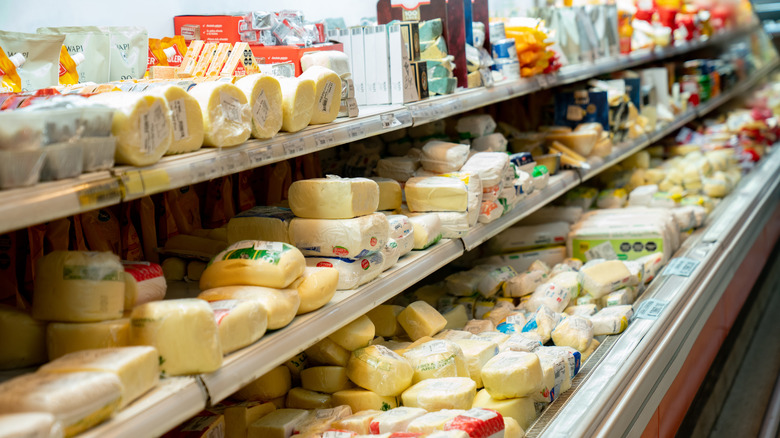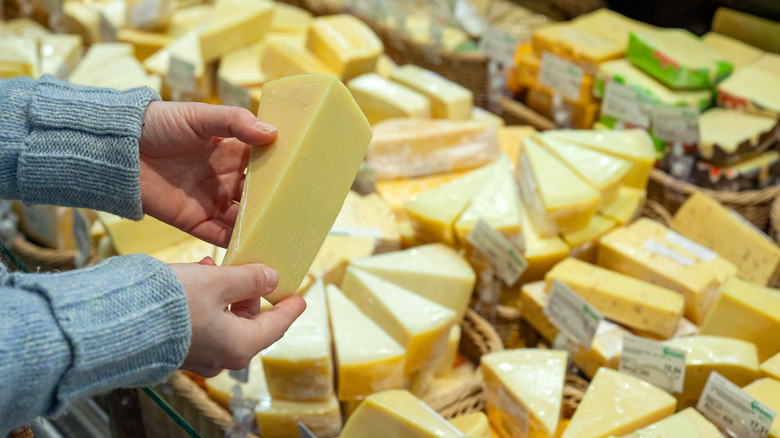Why Grocery Stores Wrap Cheese In Plastic But You Shouldn't
To many people, the most heavenly section of any grocery store is the cheese counter. Whether you're searching for the perfect type of melting cheese for a gourmet panini or a wedge to pair with wine at a book club, there's no holier place — especially if Swiss is involved. After surveying the options and snagging some plastic-wrapped pieces, it's best to strip the cheese of its sheer wrapping once you return home. This isn't so you can admire it more closely or cut off a chunk to snack on, although both decisions are valid. Instead, removing the plastic wrap from store-bought cheese is essential to keep it fresh and flavorful for as long as possible.
Supermarkets sell cheese wrapped in plastic for a couple of reasons. From blue-veined gorgonzola to vivid orange cheddar bright enough to rival a sunset, the transparent covering is best at displaying a cheese's beauty, whether in shade or shape. Being able to glimpse inside also makes it easier to determine if Gouda is satisfyingly smooth or Brie's bloomy rind is intact. However, the other leading rationale behind plastic-wrapped cheese is that it won't be on store shelves long — a no-brainer if you find yourself gazing at it longingly.
The clingy coating that cheese comes in is only suitable for short-term storage. Refrigerating wedges of cheese for safekeeping without peeling away the plastic wrap can be a big, moldy mistake. Save yourself from disappointment and prevent spoilage by following some simple cheese storage tips.
The case for storing cheese sans plastic wrap
Cheese is alive, literally, and plastic wrap can kill it. The process of making cheese depends on the interactions between lactose and live cultures. Ranging from bacteria to molds, the varied microorganisms affect cheese's smell, taste, texture, and color. But cheese continues to change and breathe even as it travels from store shelves to your fridge. When it's left in plastic wrap, the lack of air causes it to expire sooner.
One risk of storing cheese in cling wrap is that foul gasses will remain trapped inside. For instance, ammonia is natural in cheese-making, but it intensifies when confined for long periods. The unpleasant result will be extra stinky cheese. Too much ammonia on a cheese's surface can sour its scent and flavor. While it's sometimes possible to counteract this by unwrapping the cheese and letting it breathe at room temperature, if an hour passes and it's still gnarly, say goodbye. Into the bin the cheese goes.
The other glaring issue with plastic-wrapped cheese is that the clear packaging traps moisture, encouraging mold growth. You might think that isn't a big deal. After all, isn't all cheese mold? The short answer is no. While fungi are standard for certain cheeses, like blue-hued Gorgonzola, most aren't meant to mold. The flourishing of certain fungi can ruin the flavor of your cheese, so it's best to avoid the issue altogether. The easiest way is to swap plastic wrap for a less smothering storage solution.
How to store cheese to slow spoilage
While plastic wrap is always a no-no, the best storage method depends on the kind of cheese. Categorized based on moisture content and how it's ripened, there are soft, semi-soft, semi-hard, and hard cheeses as well as unripened, mold-ripened, and bacteria-ripened ones. Soft Brie needs some moisture to prevent it from drying out. Unripened ricotta, more short-lived than its aged counterparts, should always be securely sealed. Hard Parmesan requires a little air. The easiest way to accommodate all kinds of cheese is to store them in lidded plastic or glass containers, ideally ones with vents.
With the option to close or open the vent on each container, you can control the airflow and moisture levels affecting each wedge of cheese in your fridge. Keeping the vent open offers sufficient breathing room for the types of cheese that need it. Similarly, securely locking the vent and the lid helps preserve the moisture and freshness that's favorable to other varieties. Semi-hard and hard cheeses can also benefit from being rewrapped in parchment paper before storage. And as far as herbaceous or fruit-coated chèvre logs go, they can be left in their vacuum-sealed plastic up until you start digging in with crackers.
Regardless of the storage method, though, the location should be the same: All cheese is best kept cold in the fridge. As long as they aren't wrapped in plastic, you're entitled to extra time with your beloved wedges.


